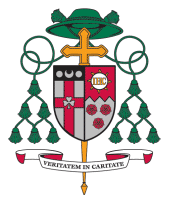

Papal Honors
The Holy Father can bestow one of three levels of honor to any priest in the Catholic Church: protonotaries apostolic, honorary prelates (domestic prelate), and chaplains of His Holiness (papal chamberlain). Contrary to common belief, Monsignors (the title given to anyone holding one of the three aforementioned honors) have no more juridical authority than any other priest and he is paid the same as any other priest, too. Parochial Vicars (formerly known as Curates or Assistant Pastors) are paid a little less than their immediate superior, the parish Pastor. Normally, though, a Pastor or a priest working in the Chancery Office, is made a Monsignor to honor the work he has done over the years for the diocese. The authority and the pay grade of any cleric is based on his assignment from the bishop. Being a Monsignor is purely ceremonial and one of honor not one of legal or sacramental effect. At the same time, however, the naming of Monsignors is one poignant way the local bishop has to identify and honor some of his own clergy.
It is not a popularity contest since no one votes for nor is one a candidate for Monsignorship. Only the bishop submits names to the Holy See and it is up to the Roman Pontiff to decide who is given the 'sacred purple' as they say. No priest aspires to be a Monsignor but I have never found one verified case of a priest who actually refused the honor. Many have claimed to have rejected the title, just as some have claimed to have refused being made bishop, yet, there is never any proof of such 'humility'. In reality, there are some political favors being given fulfilled for those loyal to the bishop in some cases and there are others who truly are role models and beacons of personal holiness. Unfortunately, when a good, exceptional, holy and deserving priest is overlooked for such papal honors while numerous mediocre contemparies are recognized, it almost seems an act of injustice.
While not advocating a democratic or republican reform of Holy Mother Church, I do see merit in at least offering the people (parishioners and lay faithful of the diocese) and the clergy (deacons and priests) an opportunity to SUGGEST names to the local bishop for his consideration to nominate as possible Monsignors by the Pope. No one is denying the bishop his legitimate right and prerogative to recommend or withhold any name he sees fit, however, if the general public believe they have some input, albeit consultative and not deliberative, I think it would help. This way, the old addage might finally evaporate: "better to not be made a Monsignor and have people ask 'why didn't that nice priest become one?' rather than be made a Monsignor and have people ask 'how the heck did he become one?'"
Father Bob Levis would NEVER ask nor want to be made a Monsignor but if there were ever a priest who DESERVED to be made one, it is he. Ordained 60 years ago, he worked tirelessly at Gannon University teaching philosophy and theology for most of his priesthood AND helping our in nearby parishes. He was the founding Director of the Pontifical Center for Catechetical Studies; President Emeritus and co-founder of the Confraternity of Catholic Clergy; author of "Jesus, The Catchism and Me; co-host of weekly TV series on EWTN, "Web of Faith." An advocate and supporter of Catholic home-schooling, Father Levis tours the country giving talks, lectures, retreats and missions, etc. Active as ever, even though compelled to retire from being a college professor at age 70, he has been working just as hard these last 16 years as he did for the first seven decades. His orthodoxy, piety, wisdom, and pastoral compassion are legendary. He has done enormous good for his alma mater, his diocese, his bishop, his parishes, his students, his spiritual directees, et al.
The Archdiocese of Saint Louis recently made 28 Monsignors and the Diocese of Allentown made 18 Monsignors this past February. This seems to dispel the unwritten legend that there is some magic formula (only 10% of the diocesan presbyterate can be made Monsignors) determining how many priests the local bishop can propose to Rome for papal honors. Some say since you cannot honor everyone, then honor no one. Phooey! I have nothing but respect and admiration for my older colleagues who gave their entire lives to the Church and endured more hardship and made more sacrifices than I did or ever will make. We need some mechanism to honor the exceptional men of the Church who have lived holy lives of distinction. Their example encourages the rest of us. No, we middle-aged and younger clergy are not dreaming of becoming Monsignors someday, rather, we want to imitate the dedication and integrity of our beloved elder brothers while at the same time showing respect and honor to them. Of course not everyone can be honored, for it then lessens the particular honor itself. Yet, to say no one should be recognized is a form of negative socialism, I think. Others, cynically claim the papal honors are abused by some bishops who use it merely to reward cronies and the good old boys who function as 'yes' men rather than the faithful, loyal men in the trenches, who really live by the rules. Hopefully, these are the minority in any event.
There will never be Monsignor ballots in the bulletins and thankfully no priests 'running for the office' as some sort of candidate, either. Nevertheless, every now and then God blesses the church and a particular diocese with exceptional men, like Father Levis, who deserve and SHOULD be made a Monsignor in gratitude for his enormous labors of love. That's just my opinion, however, and I am unanimous in it.







